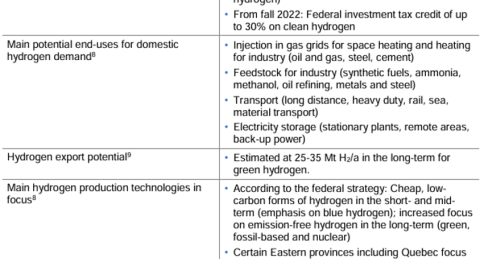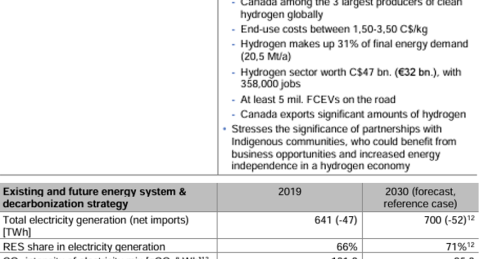Canada
Green Hydrogen Vision
As a clean and scalable solution, green hydrogen is essential to Canada’s decarbonization goals. To achieve net-zero emissions, it is crucial to decarbonise sectors that produce the most significant amounts of greenhouse gas (GHG) emissions, such as large industrial processes, freight transportation, and manufacturing.
According to Environment and Climate Change Canada, manufacturing accounts for a third of all facility-reported emissions in the country. The energy required to power these processes contributes heavily to carbon emissions.
It is understood that grid-level electricity alone will not suffice to power these sectors in the pursuit of a net-zero economy. However, green hydrogen can be produced at a scale sufficient to address even the most substantial decarbonization challenges.
The potential of green hydrogen to play a key role in decarbonizing the economy is clear, as it offers the cleanest form of energy at a necessary scale to ensure that Canada achieves net-zero emissions and is well-positioned to compete in future markets.
National Strategy
Canada is one of the leading countries in the development of hydrogen technology and the production of grey hydrogen. In December 2020, the country unveiled its federal hydrogen strategy which positions hydrogen as a key opportunity to stimulate economic growth, achieve climate neutrality, and diversify the oil and gas sector. The strategy focuses on both blue and green hydrogen, while emphasizing Canada's advantageous conditions for producing fossil fuel-based hydrogen.
By 2050, the strategy aims for Canada to become one of the top three producers of "clean hydrogen" globally as well as a significant exporter. It is projected that by this time, hydrogen will account for about one-third of the final energy demand, primarily in areas such as space and process heating, as industrial feedstock, for transportation, and for electricity storage. Several Canadian provinces have also developed their own hydrogen strategies, tailored to their unique energy resources and assets.
With substantial potential for both onshore and offshore wind energy, along with significant hydropower capacity, Canada is well-positioned to become a green hydrogen exporter. This is especially true for the Atlantic provinces, which are closest to Europe and have a great potential for green hydrogen production and transatlantic export. Additionally, Western Canada holds considerable potential for blue hydrogen production due to its extensive natural gas reserves and available CO2 storage sites.
Impact Targets
Given below is a comprehensive overview of what the Canadian Government has planned in terms of the key target areas of development

Policy Spotlight
- In the 2022 Fall Economic Statement, the federal government announced the Clean Hydrogen Investment Tax Credit (CHITC), a refundable investment tax credit for investments made in clean hydrogen production based on hydrogen's life cycle carbon intensity. This critical investment in a growing energy source will help create promising middle-class careers, ensure that Canadian companies can remain globally competitive and encourage using clean energy to reduce pollution. The credit will apply to electrolysis and natural gas reforming projects if emissions are abated with carbon capture, utilization, and storage (CCUS). Canada will continue to review eligibility for other production pathways going forward.
- The Canada Infrastructure Bank (CIB) has offered a lot of financing for projects aimed at decarbonisation.
- The CIB has launched a $500 million Charging and Hydrogen Refueling Infrastructure Initiative to help eliminate barriers to adopting zero-emission vehicles.
- In March 2023, the CIB announced it would provide $277 million in financing for the Varennes biorefinery and hydrogen electrolysis project.
- Additionally, through its Project Acceleration program, the CIB provides loan funding for front-end engineering and design (FEED) expenditures related to hydrogen production projects.
- In collaboration with renewables developer Abraxas Power, French energy company EDF has announced the establishment of a joint venture called the "Exploits Valley Renewable Energy Corporation" (EVREC). This venture aims to create a gigawatt-scale green hydrogen and ammonia facility in Newfoundland and Labrador, Canada’s easternmost province. In October 2024, Abraxas registered the project for an environmental assessment with the provincial government after securing over 300 square kilometres of Crown Land for development. The initiative will include three wind farms with a total capacity of 3.5GW in central Newfoundland, a 150MW solar power array, and a 2.6GW green hydrogen and ammonia production plant in Botwood.
Financing
-
Investment: Over $100 billion in potential investments announced for hydrogen projects.
-
Tax Incentives: The Clean Hydrogen Investment Tax Credit (CHITC) offers 15–40% credits for hydrogen production projects, supporting investments of $17.7 billion by 2035.
-
Public Funding: Programs like the Clean Fuels Fund and Strategic Innovation Fund provide financial support for hydrogen production, infrastructure, and innovation. Funding is available for C$1.5 billion (€1 billion) through the “Low-Carbon and Zero-Emissions Fuels Fund,” which supports low-carbon fuels, including hydrogen.
-
International Cooperation: Agreements with Germany, Japan, and other nations to support hydrogen export projects and market access.
Government green hydrogen lead
Ministry of Energy and Natural Resources
Natural Resources Canada (NRCan)
Commissioner of the Environment and Sustainable Development

